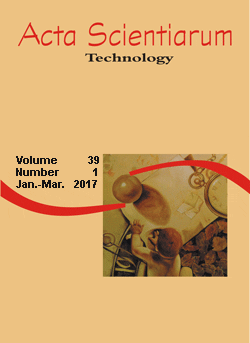<b>Effects of different cutting strategies on G-ratio in through-feed center-less grinding
DOI:
https://doi.org/10.4025/actascitechnol.v39i1.29224Keywords:
center-less grinding, G-ratio, surface roughness, cutting speed.Abstract
Grinding is the main manufacturing process used in finishing operations. Center-less grinding is widely used in the production of auto parts e.g. roller bearings, valve stem and stem of shock absorbers. Center-less grinding is used in large-scale production due to shorter time and higher flexibility. However, the set-up of the grinder is complex and slow, and depends on the operators´ ability. The choice of the best parameters in the process is important to define exactly the cutting strategy and to optimize the process. Current study analyzes the input parameters: feed rate and type of materials on the responses G-ratio, surface roughness, and roundness. Thus, stems of shock absorbers were used as work pieces on the shop floor. Cutting speed and grinding wheel type were constant. The input parameters comprised feed rate and type of materials (1025 and 1045). Responses were surface roughness, roundness error and G-ratio. Results demonstrated that the kinds of tested material was the parameter that most influenced G-ratio and surface roughness. Moreover, feed rate had little influence on the quality of the work pieces, mainly on roundness error.
Â
Downloads
Downloads
Published
How to Cite
Issue
Section
License
DECLARATION OF ORIGINALITY AND COPYRIGHTS
I Declare that current article is original and has not been submitted for publication, in part or in whole, to any other national or international journal.
The copyrights belong exclusively to the authors. Published content is licensed under Creative Commons Attribution 4.0 (CC BY 4.0) guidelines, which allows sharing (copy and distribution of the material in any medium or format) and adaptation (remix, transform, and build upon the material) for any purpose, even commercially, under the terms of attribution.
Read this link for further information on how to use CC BY 4.0 properly.



















8.png)




